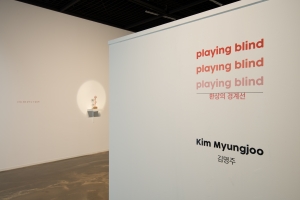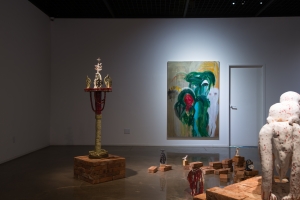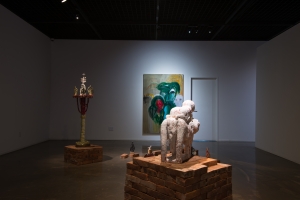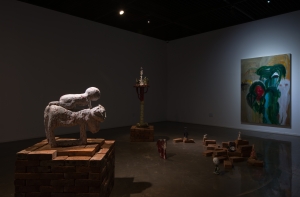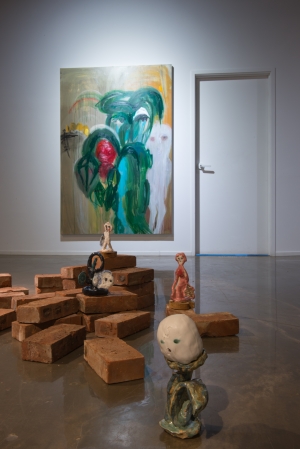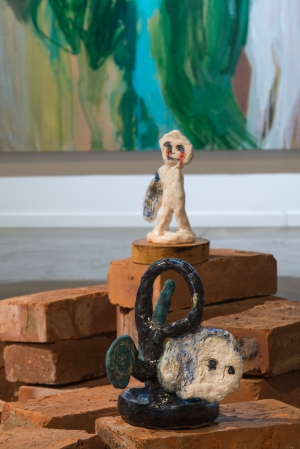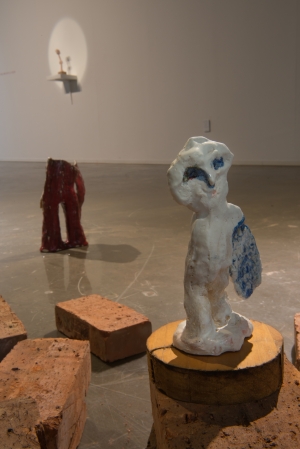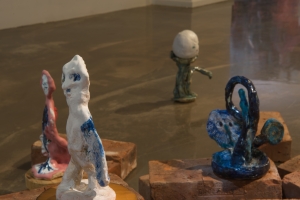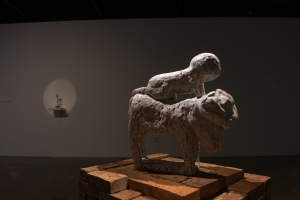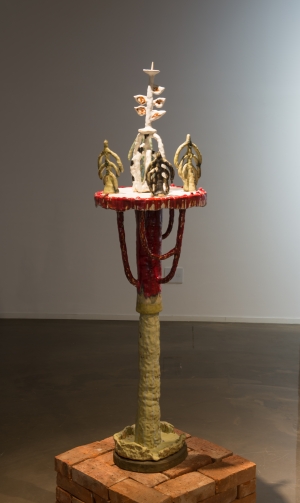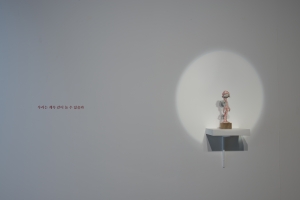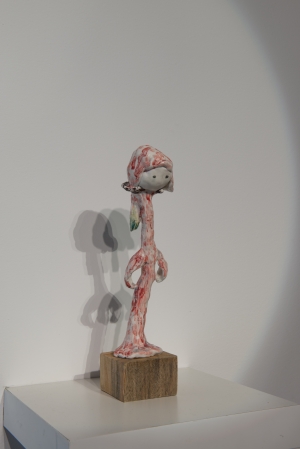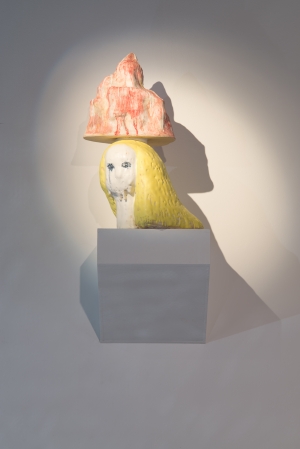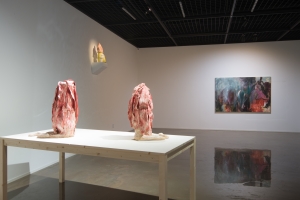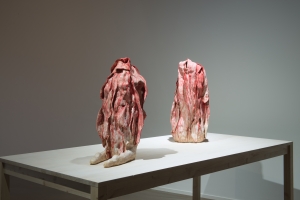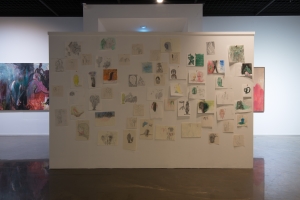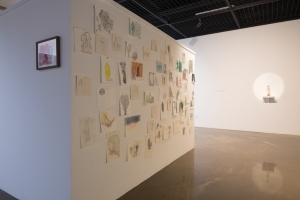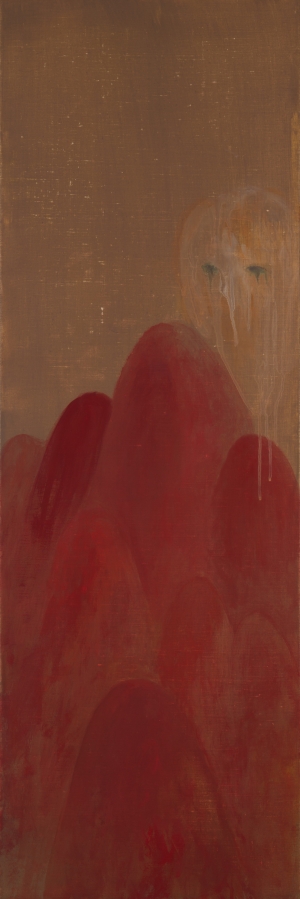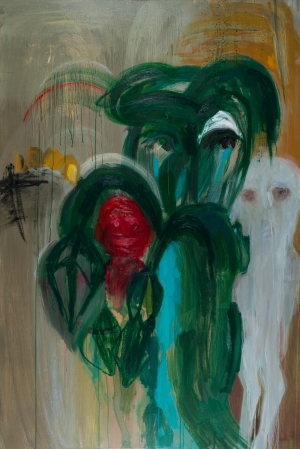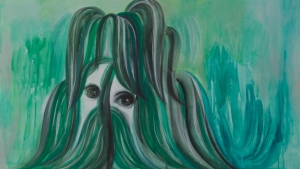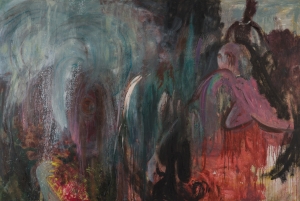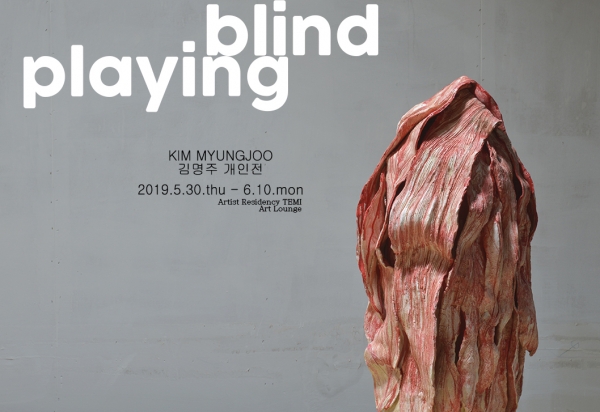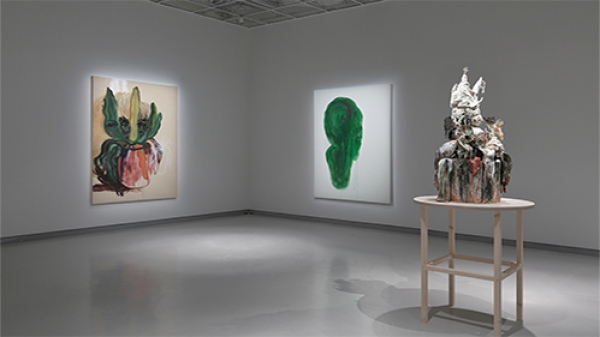전시 EXHIBITION
개인전Playing Blind
-
전시전경
-
전시전경
-
전시전경
-
전시전경
-
전시전경
-
나의 작은 것들
My little small things
-
나의 작은 것들
My little small things
-
나의 작은 것들
My liffle small things
-
메리의 기억
Memory of Mery
-
눈이 있는 촛대
Bougeoir with eyes
-
채송화
-
채송화
-
산, 그리움 Ⅱ
Nostalgia
-
전시전경
-
전시전경
-
playing blind
-
전시전경
-
전시전경
-
산, 그리움 Ⅰ
Nostalgia
-
숨기 장난 Ⅰ
Cache-cache
-
숨기 장난 Ⅱ
Cache-cache
-
악몽에서 깨어나는 순간
-
김명주 개인전 영상
< Playing Blind >
우리는 계속 같이 놀 수 있을까.
이번 작업은 중년이 되어 돌아온 고향에서 작가가 어릴 적 뛰놀던 마당을 떠올려보며 느껴지는 마음을 형상화하여 표현한 작품들이다. 유년 시절에 겪는 악몽과 같은 알 수 없는 두려움, 공포심, 때론 꿈인지 실제였는지 기억이 나지 않는 환상과의 경계들을 더 이상 어린아이의 시선이 아닌 시간과 삶의 흐름을 경험하고 있는 자의 눈으로 바라본 작업들로 구성되어 있다. 특기(特記)할 만한 것은 우리는 아직도 이유없이 불안하고 두려우며 그때처럼 각자의 꿈(환상)을 때론 간직하고 살아가고 있다는 것이다. 하지만 그 환상의 경계가 과거보다 선명하고 더불어 유년기 때는 몰랐던, 시간에 따라 퇴색되어 사라질 수 밖에 없는 존재의 피할 수 없는 상실감을 알아가는 과정에 있으며 그렇기 때문에 오는 삶에의 환희를 더 느끼려 애쓰고 있다는 점이다. 누구에게나 유년 시절은 추억이고 꿈이었으며 어릴적 꿈처럼 환상이고 악몽이다. 결국은 삶의 대한 그리움, 되돌릴 수 없는 장소이며 마음이다; 어머니의 젊음같은 그리움이며 다시 뛰어 놀 수 없는 마당이며 회복할 수 없는 희미해진 마음들이다.
나는 2012년부터 시작된 <내면 풍경> : ‘자신의 그림자를 만지다’ - ‘불멸의 앞에서’ - ‘망각, 검게 변하다’ 시리즈로 마음의 애도하는 과정이 시간의 평행선 사이에서 어떻게 시작하며 그 심연에 얼마나 깊게 빠져들 수 있는지, 또한 그럼에도 불구하고 퇴색해버리는 잔인한 인간의 망각성을 개인적 체험을 바탕으로 표현했었다. 몇 년에 걸친 작업과정 속에 나의 세라믹은 자신의 또 다른 감각적 기관의 때달음임을, 다시 말해 마음에서 손끝으로 전해오는 동시 번역임을, 또한 이 시리즈는 작업할 때 몰입의 중요성을 다시 알게 해준 놀라운 경험이었다.
2015년 한국에 들어와 가을부터 시작한 ‘어두움 후 빛’ 과 ‘노스탈지아’, ‘조용한 빛’ 그 외 작품들은 <내면 풍경>의 연장선으로 볼 수 있는데 머물렀던 타지를 향한 노스탈지아, 영원히 어디에도 정착하지 못할 것 같은 마음의 상태를, 환경에 쉽게 영향받는 존재의 불완전함과 불안정함, 우리가 안식하고자 하는 영혼의 고향을 찾기 위한 절망과 또 그럼에도 불구하고 항상 존재하는 삶의 환희를 표현하려 했으며, 2017년에 발표했던 <비밀의 형상들> 시리즈는 한 때의 푸릇한 생명력을 잃어버린 식물의 시드는 모습을 바라보며 그것에서 조차 지나간 형상이 남아있음을, 간직함을 보며 필사적인 삶에 대한 의지, 경외심, 또한 피할 수 없는 존재의 상실감을 표현했다. ‘생각하는 식물’- ‘식물의 눈’-‘잎으로부터’-‘식물, 깨어남’-‘현현’ 등의 시리즈 등이다. 하지만 ‘식물의 몸’과 같은 작업에서는 죽어가는 존재이기 때문에 역으로 그 혈기 왕성한 육체성, 그러기에 훼손당할 수 있는 몸 (Body), 즉, 육체와 영혼에 대해 < 내면 풍경 > 이후 좀 더 깊게 작업할 수 있었다. 이 때 부터는 지금까지의 입체 작업을 위한 준비 드로잉들이 독립된 회화 작품으로 창작되기 시작했다.
-
입 없는 눈동자의 시선이 머무는 곳
김소라 (OCI 미술관 수석 큐레이터)
지난봄 김명주와 마주했을 때 그녀는 차분하면서도 자못 들떠있는 모습이었다. 이제 막 피어오르는 꽃망울에, 새로 입주한 창작공간에, 처음 접하는 낯선 이(필자)에, 그리고 곧 탄생하게 될 작업 계획으로. 여러 이야기를 주고받으며, 이번에는 아주 커다란 채송화를 빚을 거라고 했다. 비정형적인 형태도 도전적이지만 작품속에 자신의 유년 시절을 담아보겠다고 눈을 반짝였다. 막상 가마에 들어갔다 나오면서 여러 변수가 생기는 세라믹의 특성상 작품이 ‘잘 나올지' 모르겠다면서도 그녀는 한껏 기대에 부풀어 있었다. 계절이 지나 다시 만난 김명주는 커다랗고 육감적인 덩어리 대신 건드리면 부러질 듯 가늘고 여린 줄기의<채송화>를 전시장에 내어놓았다. 애초 계획했던 본인의 야심작이 제작 과정에서 어떤 ‘비극'을 만나 동강났는지를 하나의 에피소드라며 담담하게 말하는 작가에게, 나는, 삶이 다 그렇지 않겠느냐고 심심한 위로를 건네고 싶었으나 차마 입술에서 말이 떨어지지 않아서 그저 가만히 듣고만 있었다. 작가의 페르소나와도 같은 작업이기에, 그것이 눈앞에서 부서지는 순간의 상실감은 타인이 섣불리 가늠할 수 없는 것이기 때문이다.
김명주의 이번 전시 《Playing blind-환상의 경계선》은 작가가 자신의 유년 시절에 보내는 오마주(hommage)다. “우리는 계속 같이 놀 수 있을까"라는 질문으로 전시를 열며 작가는 어린 날 본인이 살았던 집, 마당, 그곳에서의 놀이, 천진난만하던 나날을 다시 불러보았다. 소꿉놀이하듯 오밀조밀한 오브제들이 모여 회연을 이루는데, 동심으로 가득 차야만 할 것 같은 작품들이, 솔직히, 기괴하고 불안하다. 식물인 듯 동물인 듯 사람인 듯 보이는 오브제의 얼굴은 일그러져 있고, 작품에 그려진 눈-세상을 바라보는 그 눈은 너무 많다. 게다가 사람이라면 마땅히 등이 있어야 할 자리에는 또 다른 얼굴이, 표정이, 몸덩이가 이란성 쌍둥이처럼 조물조물 만들어져 앞뒤를 구분할 수조차 없다. 그 속에서 어떤 내러티브를 찾거나 형상을 알아보고자 하는 노력은 금세 좌절될 수밖에 없는데, ‘익숙한’ 생경감만은 끈질기게 남아 작품에서 눈을 뗄 수가 없다. 호기심으로 가득 차 있으나 두렵고, 어른들의 세상에는 포섭되지 않으나 이 세계를 공유하는 작은 존재였던 그 시절이 누구에게나 있었기에 익숙한 감정이다. 누구에게라도 유년기는 되돌릴 수 없어 마냥 그리워하는 시절이다. 특히나 오랫동안 집을 떠나있던 자가 돌아와 회상하는 과거란 온전히 균일한 속도로 흘러온 시간의 한 부분이 아니다. 오히려 이것은 시간의 내부에서 소용돌이치며 불쑥 솟아오른 파편이거나 불분명한 이유로 되풀이되는 기억이다. 논리로는 설명할 수 없는, 그렇다고 환상이라고 치부하기에는 지나치게 확연한 형태로 이미지가 각인되어 있는데, 김명주에게는 마당 한구석의 ‘채송화'와 털이 복슬복슬한 강아지 ‘메리'가 그런 존재이다. 이들은 실상 작고 보잘것없었을 것이다.
그럼에도 몇십 년이 넘도록 뇌리에 남아버렸다. 이들의 부재와 현존, 즉 더는 곁에 있지 않음과 머릿속에 선명하게 자리함은 끊임없이 엎치락뒤치락 교차하며 시간의 흐름을 환기한다. 마치 떠남과 돌아옴, 혹은 더 나아가 삶과 죽음이 그러하듯. 이 전시에서 김명주는 유독 서로 마주 보거나 등을 맞대고 있는 작품 배치로 대비를 강조한다. 우선, 전시 자체도 크게 두 파트로 나누어진다. 전시의 도입부에서는 과거 살았던 골목과 주변 사물을 어린아이의 시점으로 소환하고, 후반부에서는 시간이 흘러 그 시절을 관조하고 그리워하는 짐짓 어른의 태도를 취한다. 그런가 하면, 작품 간의 관계도 일정 거리를 두고 짝을 이루어서 페인팅 <숨기 장난 I>과 <숨기 장난 II>는 나란히 걸고, <숨기 장난 II>는 저 멀리 반대편 벽면의 <악몽에서 깨어나는 순간>을 마주하고, 선반 위의 세라믹 작업 <채송화>의 맞은편에는 <산, 그리움 II>가 높은 선반에 놓여 시선을 교차하며 굽어보는 식으로 서로를 조우한다. 각각의 작품은 또 어떠한가. 입체적으로 보여줄 수 있는 세라믹의 특징 때문이라지만, 그렇다고 굳이 한 쌍이어야 할 이유는 없는데도, 한 인물의 다른 두 성격처럼 <나의 작은 것들>에서는 하나의 오브제 앞뒤로 각기 다른 표정이붙어있다. <메리의 기억>에서는 등장인물의 등에 제 몸과 꼭 닮은 제 2 의 몸이 올라타 있는데, 어떻게 봐도 이둘은 서로 다른 존재라기보다는 동일인의 분신처럼 인식된다. 작업의 양면성은
듯 시선을 비껴 대면하는데, 그 몸의 상체는 지나치게 비대한 데 비하여 꿇어앉은 다리는 어린아이의 것처럼 가냘파 저 큰 몸을 어떻게 지탱할 수 있을까 안쓰러울 지경이다. 게다가 그 상체란, 거대한 식물 잎사귀처럼 보이나 핏빛으로 채색되어 고깃덩어리보다 더 짙은 살 내음을 풍길 것 같다. 줄곧 상충하고 경계하며 서로를 대하는 작품들은 각기 다른 존재라기보다 모두 하나의 자아에서 분열된 다중적 인격체들이다. 나의 이런 모습, 저런 모습이 표출되어 큰 눈동자를 굴리며 서로를 탓하듯, 체념하듯, 이해하듯, 가까스로 포용하듯, 탐색전을 펼치는 것이다.
왜 하필 작가는 이 전시에서 유년기를 그리려고 했을까, 그건 아마도 그때 이후로 그녀의 자아는 줄곧 나누어지기만 하였기 때문일 것이다. 살던 곳을 떠나고, 낯선 땅을 헤매고, 다시 돌아올 때까지 다른 시점, 다른 장소에서는 다른 표정을 지어야 한다는 것을 익혀온 사람에게 유년기는 유일하게 그런 사회적 태도를 취할 필요가 없는 때였을지도 모른다. 김명주의 작업에서는 종종 얼굴에 눈은 강조되는 데 비하여 입은 그려지지 않거나, 있어도 입술을 꾹 다문 채 발화의 기능을 상실한 모습이다. 해외에서 오래 머무른 경험으로 미루어 볼 때 언어에 민감할 법도 한데 오히려 작품의 목소리를 낮추고 눈빛으로 호소하는 이유가 나는 줄곧 궁금했는데, 정작 작가가 복귀하고 싶은 것은 정확한 언어를 구사하지 않아도, 바라보는 것만으로 세상의 본질을 파악하고 다가갈 수
있었던 그 태도 자체이지 않을까 짐작해 본다. 우리는 모두 ‘계속 같이 놀 수 있을까'라는 질문의 답을 이미 알고 있다. 한 번 떠나간 시간은 다시 돌아오지 않음을, 영원히 그때와 같아질 수는 없으리라는 것을. 김명주가 재건하려 한 과거는 결국 재건되지 않는 것이다.
이를 알고 있기에, 작품 속에서 끊임없이 환기되는 심리의 양가성은 회귀 불능의 고통을 상기한다. 과거를 향한 시선은 자아의 내면으로 향한 것과 다름 없다. 두 동강이 나버린 미완의 <채송화>처럼 분리된 자아는 어떻게 화해할 수 있을까. 이 정답 없는 긴 여정에서 김명주의 다음 작업이 기다리고 있을 것이다.
Where the Eyes of the Mouthless Linger
Sora Kim (Senior Curator, OCI Museum of Art)
When I first encountered Myung-Joo Kim last spring, she seemed calm but quite excited. My first encounter with her was to hear about the plans for her work amid the slowly blooming flowers in the creative space she had just moved into. While talking about different topics, she said she’s going to make an enormous Chaesongwha. With her eyes twinkling, she said it is challenging to create an atypical shape, but she wants to portray her childhood through her art. As there may be different variables when ceramic goes in and comes out of a kiln, she was concerned about her work coming out alright, but she seemed enthusiastic at the same time.
When I met Kim after a season has passed, she was presenting Chaesongwha, a fine delicate flower that seemed so vulnerable, which was the opposite of her initial plan to create a large, voluptuous flower. Listening to the artist calmly talking about how her ambitious plan came across as a “tragedy” that had to be changed, I wanted to deeply sympathize with her and say that that’s how life is. However, I just sat still and couldn’t say a word. Art is a persona of the artist, and others cannot dare to imagine the loss the artist feels when their work falls apart before their eyes.
MyungJoo’s new exhibition Playing Blind ? Edges of Illusions is an homage to her childhood years. She opened the exhibition with the question, “Will we be able to keep playing together?” She recalled the house she used to live in, the yard, the games, and the innocent days. A feast of exquisite objects that look like props for playing house and the art that seems to be full of the innocence of childhood. It makes me feel, frankly speaking, odd and uneasy. The face of the object that could be a plant, an animal, or even a human being has been distorted, and there is one too many eyes on the piece - the eyes looking at the world. And where there’s supposed to be the back - if it were a person - is another face, an expression, and a body like fraternal twins, so that you cannot tell which side is the front. The effort to discover a narrative in the work or to figure out the shape is soon frustrated. However, the “familiar” unfamiliarity lingers and makes one keep staring at the piece. It’s the familiar feeling that we all experienced as a little child - full of curiosity, yet afraid, not included in the world of adults, but sharing a world of our own.
Childhood days are the time we all miss and we cannot go back to. Especially when the childhood days one reminisces about after having left home for a long time are given more weight than the other time that has passed. They are pieces of memory that spike up while swirling inside you or memories that continue to be recalled without a clear reason. Something that cannot be explained with logic, but too clear of an image to be considered an illusion. To Kim, these images are a Chaesongwha in the corner of her yard and a fluffy Mery puppy. They were probably tiny and insignificant. However, they have been stuck in her head for several decades. Their existence, or lack thereof, - no longer here with her, but still clearly existing in her head - endlessly turns over and over, reversing the flow of time. Just like leaving and returning, or furthermore, like life and death.
In this exhibition, Kim emphasizes contrast by having the pieces face each other or stand back to back. Above all, the exhibition is divided into two parts. In the introductory part of the exhibition are the small alleys and objects seen from the perspective of a child. In the latter part, the perspective shifts to that of an adult; contemplating and reminiscing about the time that has passed. On the other hand, the pieces are presented in pairs. The paintings Cache-cache I and Cache-cache II are hung next to each other. Cache-cache II is facing The Moment Awakening from a Nightmare, which has been hung on the other side. On the other side of the ceramic work on the shelf, Chaesongwha, is Nostalgia II on a high shelf, looking down to the piece across the room. How about each piece? Although ceramic art is three-dimensional, it is not necessary to create them in pairs. However, in My Little Small Things, each object has another face on the other side, as if showing two personalities of one person. In Memory of Mery, someone is on top of someone else who looks exactly like the one on top. In many ways, they look like alter egos - not two different people. The dual nature of the work is portrayed passionately in Playing Blind. Two bodies without a face kneel down face each other, but they look away as if they cannot make an eye contact. The upper body is rather large compared to the knelt-down legs that look like a little child. They seem so fragile that I feel sorry they have to support such a big body. The body looks like a large leaf, but it is colored in red, like blood, and I can almost smell the meat. Continuously in conflict and warring against each other, the pieces seem to have come out from one ego rather than standing on their own. One side of me and the other side of me have both been expressed. They roll their big eyes, as if blaming, giving up, understanding, barely embracing, or exploring each other.
Why did the artist try to depict her childhood in this exhibition? Perhaps it was because her ego has kept splitting since then. From leaving her familiar home, wandering around in strange places, then returning home, she learned that she has to put on a different mask in different places. Childhood was the only time she did not have to have such a social attitude. In many of Kim’s pieces, the eyes are accentuated, whereas the mouth is missing or closed tightly ? having lost all utterance. In light of the fact that she had spent extensive time overseas, she could be sensitive to language. I have been wondering why her art was quiet and spoke with only their eyes. I think she intended to convey the attitude that you can look at and approach the essence of the world with your eyes, even without having to speak with words.
We already know the answer to the question, “Will we be able to keep playing together?” That time has passed and it will not return. We will never be the same. The past Kim strove to rebuild can never be restored. With this knowledge, an ambivalence of emotions is endlessly brought up through her work, recalling the pain of her inability to go back. Eyes turned upon the past are eyes looking into her inner self. How could the split inner self - like the incomplete Chaesongwha that was broken into two pieces - be at peace with each other? Kim’s next project will be waiting for us in this long journey without an answer.
- 기간
- 2019-05-30 ~ 2019-06-10
- 관련행사






